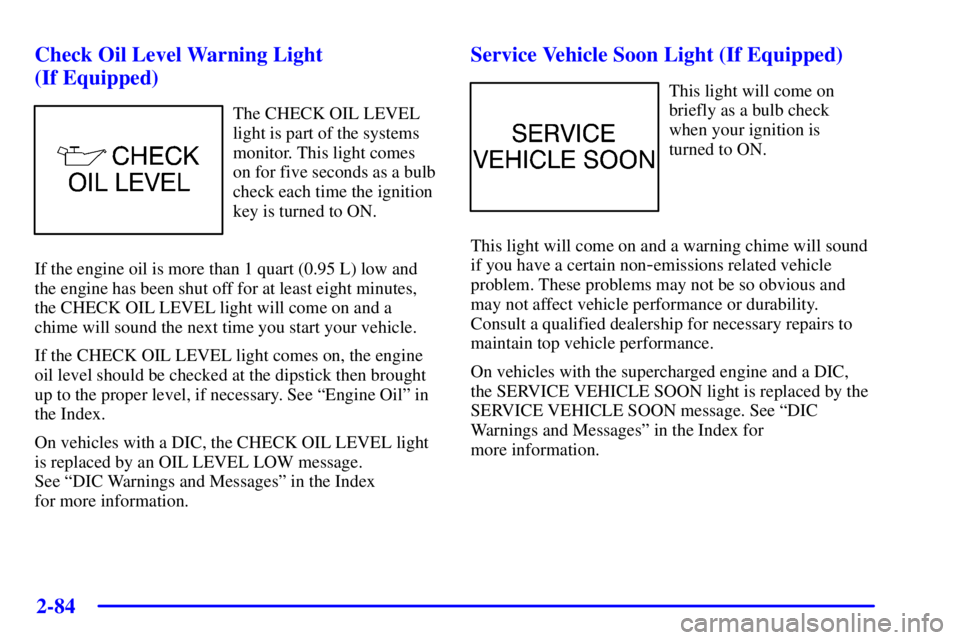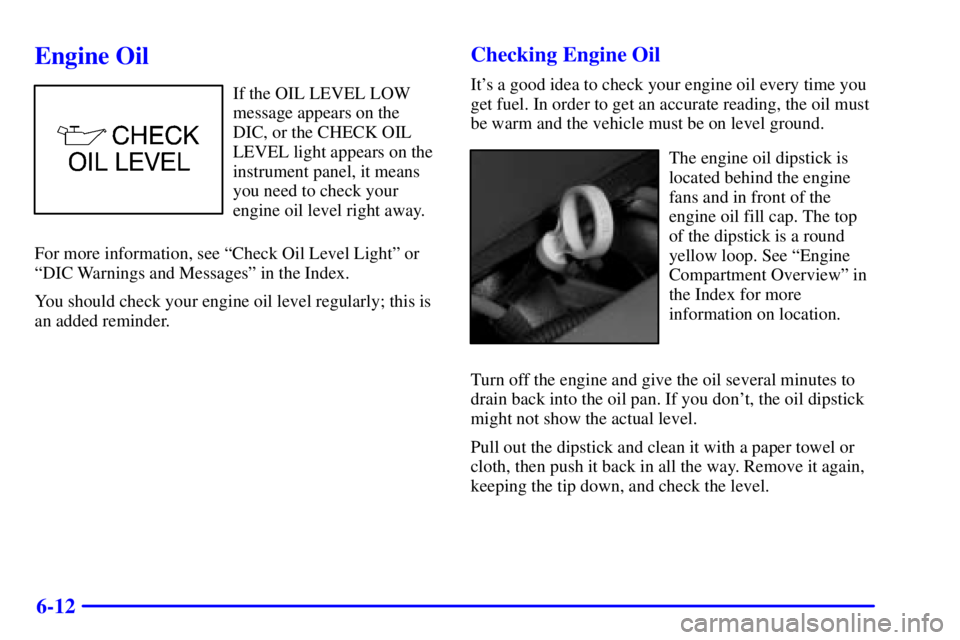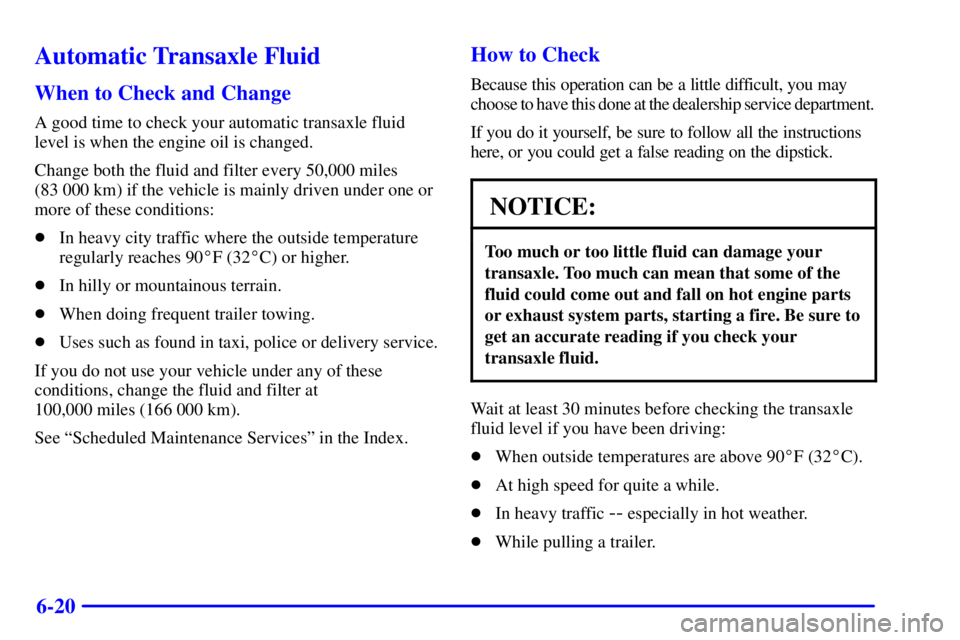Page 12 of 413
Service Station Guide
Oil Viscosity
Engine Oil
See Section 6
Engine Oil Dipstick
See Section 6
Cooling System
See Section 5
Hood Release
See Section 6
Windshield Washer
Fluid
See Section 6
Spare Tire Pressure
See Section 5
Alternate
Fuel Door Release
See Section 6
Battery
See Section 6
Tire Pressure
See Section 6
For
a More
Detailed Look at
What's Under the Hood
See Section 6
Fuel
Use unleaded only.
See Section 6
for octane ratings.
Page 151 of 413

2-84
Check Oil Level Warning Light
(If Equipped)
The CHECK OIL LEVEL
light is part of the systems
monitor. This light comes
on for five seconds as a bulb
check each time the ignition
key is turned to ON.
If the engine oil is more than 1 quart (0.95 L) low and
the engine has been shut off for at least eight minutes,
the CHECK OIL LEVEL light will come on and a
chime will sound the next time you start your vehicle.
If the CHECK OIL LEVEL light comes on, the engine
oil level should be checked at the dipstick then brought
up to the proper level, if necessary. See ªEngine Oilº in
the Index.
On vehicles with a DIC, the CHECK OIL LEVEL light
is replaced by an OIL LEVEL LOW message.
See ªDIC Warnings and Messagesº in the Index
for more information.
Service Vehicle Soon Light (If Equipped)
This light will come on
briefly as a bulb check
when your ignition is
turned to ON.
This light will come on and a warning chime will sound
if you have a certain non
-emissions related vehicle
problem. These problems may not be so obvious and
may not affect vehicle performance or durability.
Consult a qualified dealership for necessary repairs to
maintain top vehicle performance.
On vehicles with the supercharged engine and a DIC,
the SERVICE VEHICLE SOON light is replaced by the
SERVICE VEHICLE SOON message. See ªDIC
Warnings and Messagesº in the Index for
more information.
Page 296 of 413
6-11 Engine Compartment Overview
When you open the hood on the 3800 (L36) engine (3800 Supercharged (L67) engine similar), here's what you will see:
A. Engine Coolant Recovery Tank
B. Power Steering Fluid
C. Automatic Transaxle
Fluid DipstickD. Brake Master Cylinder
E. Windshield Washer
Fluid Reservoir
F. Radiator Pressure CapG. Engine Oil Dipstick
H. Engine Oil Fill Cap
I. Engine Air Cleaner/Filter
Page 297 of 413

6-12
Engine Oil
If the OIL LEVEL LOW
message appears on the
DIC, or the CHECK OIL
LEVEL light appears on the
instrument panel, it means
you need to check your
engine oil level right away.
For more information, see ªCheck Oil Level Lightº or
ªDIC Warnings and Messagesº in the Index.
You should check your engine oil level regularly; this is
an added reminder.
Checking Engine Oil
It's a good idea to check your engine oil every time you
get fuel. In order to get an accurate reading, the oil must
be warm and the vehicle must be on level ground.
The engine oil dipstick is
located behind the engine
fans and in front of the
engine oil fill cap. The top
of the dipstick is a round
yellow loop. See ªEngine
Compartment Overviewº in
the Index for more
information on location.
Turn off the engine and give the oil several minutes to
drain back into the oil pan. If you don't, the oil dipstick
might not show the actual level.
Pull out the dipstick and clean it with a paper towel or
cloth, then push it back in all the way. Remove it again,
keeping the tip down, and check the level.
Page 298 of 413
6-13
When to Add Engine Oil
If the oil is at or below the ADD mark, then you'll need
to add at least one quart of oil. But you must use the
right kind. This part explains what kind of oil to use. For
crankcase capacity, see ªCapacities and Specificationsº
in the Index.
NOTICE:
Don't add too much oil. If your engine has so
much oil that the oil level gets above the
cross
-hatched area that shows the proper
operating range, your engine could be damaged.
Add engine oil at the engine
oil fill cap near the oil
dipstick. See ªEngine
Compartment Overviewº
in the Index for more
information on location.
Be sure to fill it enough to put the level somewhere in
the proper operating range. Push the dipstick all the way
back in when you're through.
Page 305 of 413

6-20
Automatic Transaxle Fluid
When to Check and Change
A good time to check your automatic transaxle fluid
level is when the engine oil is changed.
Change both the fluid and filter every 50,000 miles
(83 000 km) if the vehicle is mainly driven under one or
more of these conditions:
�In heavy city traffic where the outside temperature
regularly reaches 90�F (32�C) or higher.
�In hilly or mountainous terrain.
�When doing frequent trailer towing.
�Uses such as found in taxi, police or delivery service.
If you do not use your vehicle under any of these
conditions, change the fluid and filter at
100,000 miles (166 000 km).
See ªScheduled Maintenance Servicesº in the Index.
How to Check
Because this operation can be a little difficult, you may
choose to have this done at the dealership service department.
If you do it yourself, be sure to follow all the instructions
here, or you could get a false reading on the dipstick.
NOTICE:
Too much or too little fluid can damage your
transaxle. Too much can mean that some of the
fluid could come out and fall on hot engine parts
or exhaust system parts, starting a fire. Be sure to
get an accurate reading if you check your
transaxle fluid.
Wait at least 30 minutes before checking the transaxle
fluid level if you have been driving:
�When outside temperatures are above 90�F (32�C).
�At high speed for quite a while.
�In heavy traffic
-- especially in hot weather.
�While pulling a trailer.